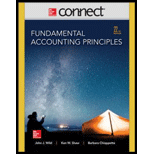
Concept explainers
Introduction:
Inventory refers to the work-in-progress, raw material or the finished goods that are assumed to be the part of the asset of the business that would be ready or are already ready to be sold. The turnover of the inventory is one of the important source of profit generation for the owners or shareholders of the company.
Requirement 1:
To Calculate:
Amount of inventories as current asset on September 28, 2013 and on September 29, 2012
Answer to Problem 1BTN
Solution:
Inventory at the end on September 28, 2013 accounts for $1,764 and the inventory at the end as on September 29, 2012 accounts for $791.
Explanation of Solution
Explanations:
Ending Inventory refers to the stock of goods and services that are in possession of the company at the end of the year. Ending Inventory is ascertained as the value of beginning inventory plus the purchases made during the year which is subtracted from the value of inventory consumed or withdrawn.
Requirement 2:
To Calculate:
Inventory as percentage of total assets on September 28, 2013 and on September 29, 2012
Requirement 2:
Answer to Problem 1BTN
Solution:
Inventory as percentage of Total Asset for the year 2013 accounts for 0.85% and for the year 2012, it accounts for 0.45%.
Explanations:
Requirement 3:
To Determine:
Relative size of Apple’s inventories compared to its other type of assets.
Solution:
Inventories of Apple Company are second smallest asset as on September, 2013.
Explanations:
Requirement 4:
To Determine:
Accounting method used by Apple Company to compute inventory accounts on the Balance Sheet
Solution:
Apple Company uses FIFO Method for computing Inventory Accounts on Balance Sheet.
Explanations:
In this case, upon reviewing the notes pertaining to statement of finance, it is ascertained that inventory of Apple Company are stated at lower of market or cost. In order to determine the cost of inventory, Apple Company uses FIFO method for managing its inventory. The inventory of Apple Company usually comprises of finished goods.
Requirement 5:
To Calculate:
Inventory Turnover for fiscal year ended after September 28, 2013 and days’ sales inventory as of September 28, 2013
Solution:
Inventory Turnover accounts for 83.4 times and days’ sales in inventory accounts for 6.04 days.
Explanations:
Inventory Turnover refers to the ratio that depicts the number of times the inventory of the company is sold over a period of time. Further the days underlying the period is divided by the formula for inventory turnover in order to identify the number of days it would require to sell the inventory.
Therefore, computation of inventory turnover is shown below:
Day’s Sales in inventory refers to the financial measure pertaining to the performance of the company that provide the investor with an idea as to how long a company takes to convert its inventory into actual sales.
Therefore, computation of the day’s sales in inventory is shown below:
Explanation of Solution
Explanations:
Requirement 3:
To Determine:
Relative size of Apple’s inventories compared to its other type of assets.
Requirement 3:
Answer to Problem 1BTN
Solution:
Inventories of Apple Company are second smallest asset as on September, 2013.
Explanation of Solution
Explanations:
Goodwill possess slightly small balance, however each account pertaining to other asset is almost double the value of inventory. Although large inventory balance is not carried by Apple Company in comparison to other assets, however inventories are still a necessary item for Apple Company.
Requirement 4:
To Determine:
Accounting method used by Apple Company to compute inventory accounts on the Balance Sheet
Requirement 4:
Answer to Problem 1BTN
Solution:
Apple Company uses FIFO Method for computing Inventory Accounts on Balance Sheet.
Explanation of Solution
Explanations:
In this case, upon reviewing the notes pertaining to statement of finance, it is ascertained that inventory of Apple Company are stated at lower of market or cost. In order to determine the cost of inventory, Apple Company uses FIFO method for managing its inventory. The inventory of Apple Company usually comprises of finished goods.
Requirement 5:
To Calculate:
Inventory Turnover for fiscal year ended after September 28, 2013 and days’ sales inventory as of September 28, 2013
Requirement 5:
Answer to Problem 1BTN
Solution:
Inventory Turnover accounts for 83.4 times and days’ sales in inventory accounts for 6.04 days.
Explanation of Solution
Explanations:
Inventory Turnover refers to the ratio that depicts the number of times the inventory of the company is sold over a period of time. Further the days underlying the period is divided by the formula for inventory turnover in order to identify the number of days it would require to sell the inventory.
Therefore, computation of inventory turnover is shown below:
Day’s Sales in inventory refers to the financial measure pertaining to the performance of the company that provide the investor with an idea as to how long a company takes to convert its inventory into actual sales.
Therefore, computation of the day’s sales in inventory is shown below:
Want to see more full solutions like this?
Chapter 6 Solutions
FUND.ACCT.PRIN -ONLINE ONLY >I<

 AccountingAccountingISBN:9781337272094Author:WARREN, Carl S., Reeve, James M., Duchac, Jonathan E.Publisher:Cengage Learning,
AccountingAccountingISBN:9781337272094Author:WARREN, Carl S., Reeve, James M., Duchac, Jonathan E.Publisher:Cengage Learning, Accounting Information SystemsAccountingISBN:9781337619202Author:Hall, James A.Publisher:Cengage Learning,
Accounting Information SystemsAccountingISBN:9781337619202Author:Hall, James A.Publisher:Cengage Learning, Horngren's Cost Accounting: A Managerial Emphasis...AccountingISBN:9780134475585Author:Srikant M. Datar, Madhav V. RajanPublisher:PEARSON
Horngren's Cost Accounting: A Managerial Emphasis...AccountingISBN:9780134475585Author:Srikant M. Datar, Madhav V. RajanPublisher:PEARSON Intermediate AccountingAccountingISBN:9781259722660Author:J. David Spiceland, Mark W. Nelson, Wayne M ThomasPublisher:McGraw-Hill Education
Intermediate AccountingAccountingISBN:9781259722660Author:J. David Spiceland, Mark W. Nelson, Wayne M ThomasPublisher:McGraw-Hill Education Financial and Managerial AccountingAccountingISBN:9781259726705Author:John J Wild, Ken W. Shaw, Barbara Chiappetta Fundamental Accounting PrinciplesPublisher:McGraw-Hill Education
Financial and Managerial AccountingAccountingISBN:9781259726705Author:John J Wild, Ken W. Shaw, Barbara Chiappetta Fundamental Accounting PrinciplesPublisher:McGraw-Hill Education





